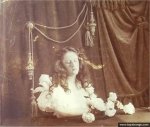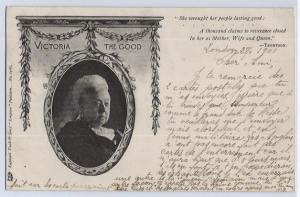 In today’s world, “Victorian” refers (by most accounts) to a certain highly ornate style of architecture, furnishings, and fashion. To some extent, this is also the lovely style with which many emo and gothic kids associate with romance and a series of degenerative lifestyle choices. But the one element of Victorian art and style that continues to fascinate us is the mourning fashions of the day.
In today’s world, “Victorian” refers (by most accounts) to a certain highly ornate style of architecture, furnishings, and fashion. To some extent, this is also the lovely style with which many emo and gothic kids associate with romance and a series of degenerative lifestyle choices. But the one element of Victorian art and style that continues to fascinate us is the mourning fashions of the day.
And it was indeed an art form and lucrative business!
 Mourning clothes were a family’s outward display of their inner feelings. The rules for who wore what and for how long were complicated, and were outlined in popular journals or household manuals which were very popular among Victorian housewives. They gave an abundant amount of instructions about appropriate mourning etiquette. If your second cousin’s cousin twice removed on your father’s dad’s side died and you wanted to know what sort of mourning clothes you should wear and for how long, you consulted The Queen or other manuals.
Mourning clothes were a family’s outward display of their inner feelings. The rules for who wore what and for how long were complicated, and were outlined in popular journals or household manuals which were very popular among Victorian housewives. They gave an abundant amount of instructions about appropriate mourning etiquette. If your second cousin’s cousin twice removed on your father’s dad’s side died and you wanted to know what sort of mourning clothes you should wear and for how long, you consulted The Queen or other manuals.
Here are a few strictly followed rules that one must adhere to in the 19th Century when you need to find something to wear out after the loss of a loved one.
- Widows were expected to wear special clothes to indicate that they were in mourning for up to four years after the death, although a widow could choose to wear such attire for the rest of her life.
- Wearing a widow cap with a veil covering your face was thought to be proper etiquette. It is rude to the dead to show your grief.
- It was considered bad luck to keep mourning clothes – particularly crape – in the house after mourning ended. This meant that crepe warehouses were at a boom!
- There were certain stages of mourning that alleviated the depression of some of the strict morbid clothing. the “full mourning” stage saw nothing but black, where “half mourning” saw shades of grey and lavender.
- And by the by, it was considered the height of rudeness to enter back into society within the first two years of mourning, so though it really matters what you wear…no one really notices it!
 Another way to remember and honor the dead was by wearing a bit of hair from your loved one in a lovely cameo or other kind of jewelry. The type of mourning was simply labeled as “hair art” and was wildly popular! Note that hair art was also used to remember a loved one period…not just a deceased loved one. Locks of a persons hair, or even several peoples hair, were taken an fashioned into ornate and unique mementos for a grieving family. To be even more ridiculously morbid, some hair jewelry was even made to be worn against the skin!
Another way to remember and honor the dead was by wearing a bit of hair from your loved one in a lovely cameo or other kind of jewelry. The type of mourning was simply labeled as “hair art” and was wildly popular! Note that hair art was also used to remember a loved one period…not just a deceased loved one. Locks of a persons hair, or even several peoples hair, were taken an fashioned into ornate and unique mementos for a grieving family. To be even more ridiculously morbid, some hair jewelry was even made to be worn against the skin!
 Ironically, this art lost it’s popularity soon after the death of Queen Victoria, who supposedly had a lock of Albert’s hair, though during her reign it was hugely popular. Why, there are even wreaths and ornate floral decorations made in shadow boxes. It is astounding how intensely intricate some of these pieces are! Still on top of hair art, Jet stones were also a favorite, especially with Queen Victoria herself whose mourning of her husband defined a time in history.
Ironically, this art lost it’s popularity soon after the death of Queen Victoria, who supposedly had a lock of Albert’s hair, though during her reign it was hugely popular. Why, there are even wreaths and ornate floral decorations made in shadow boxes. It is astounding how intensely intricate some of these pieces are! Still on top of hair art, Jet stones were also a favorite, especially with Queen Victoria herself whose mourning of her husband defined a time in history.
 So now we are moving on to the most morbid and by far creepiest example of Victorian mourning…the postmortem photographs! Everyone wishes to remember
So now we are moving on to the most morbid and by far creepiest example of Victorian mourning…the postmortem photographs! Everyone wishes to remember  a loved one and in the later half of the 19th century is was possible to do so with the invention of the camera…and a few understandably creepy ideas. There is not a photography studio today who will not only take pictures of your kids with a rabbit for Easter, but also position your dead child on a couch so you can keep that memory alive forever.
a loved one and in the later half of the 19th century is was possible to do so with the invention of the camera…and a few understandably creepy ideas. There is not a photography studio today who will not only take pictures of your kids with a rabbit for Easter, but also position your dead child on a couch so you can keep that memory alive forever.
To a Victorian, death was a part of life and facing death was a perfect way of moving on. What better way to face death then to  photograph it. These were also very tasteful pictures. We frown upon this art form today because our mentality claims it to be morbid. To a Victorian, it was a sweet, sentimental way to remember someone, especially children since the infant mortality rate was atrocious and some of these images were the only photograph of a child. It was a symbol of comfort to the Victorians.
photograph it. These were also very tasteful pictures. We frown upon this art form today because our mentality claims it to be morbid. To a Victorian, it was a sweet, sentimental way to remember someone, especially children since the infant mortality rate was atrocious and some of these images were the only photograph of a child. It was a symbol of comfort to the Victorians.
 Funerals were big business in the 19th century. With many funeral parlors offering their services from 10lbs to 5 shillings, it was easier and far more dignified to bury your loved one appropriately. And how would you announce the funeral to your friends? With personalized mourning stationary that is! They thought of all the angles, didn’t they?
Funerals were big business in the 19th century. With many funeral parlors offering their services from 10lbs to 5 shillings, it was easier and far more dignified to bury your loved one appropriately. And how would you announce the funeral to your friends? With personalized mourning stationary that is! They thought of all the angles, didn’t they?
Black bordered note paper and envelopes of every description, also … paper every width of border. Memorial Cards and return Thanks of the newest patterns. Notepaper and envelopes stamped in black relief, and illuminated in a superior manner.
Here are some other things you might need to know about mourning and death!
- Black drapes are to be hung over all of the mirrors in the home of the deceased. There is that pesky superstition about mirrors trapping the soul and binding it to the house! Another: if you look in the mirror after someone has died, you might be next!
- Clocks in the house are to be stopped at the time of death.
- Sitting up with the deceased should be done to make sure the deceased has enough attention.
- The body of the deceased shall lay in state at the house until the funeral.
- Gravestones also had symbolic designs. A rose meant you were English, a shamrock was Irish, and a thistle was Scottish. There were many others. What do you think will be on your?
 Soon after the death of Queen Victorian, mourning decree laxed and black started
Soon after the death of Queen Victorian, mourning decree laxed and black started  to become more of a fashion than of a mournful necessity. People’s ideals change and with that came a change in how people saw death. Now it was morbid, taboo, and strange to openly mourn and all that flashy attention for death changed to private depression. We even have a gross fascination with Victorian mourning garb now with Gothic-lolita fashions…which I am most definitely not against!
to become more of a fashion than of a mournful necessity. People’s ideals change and with that came a change in how people saw death. Now it was morbid, taboo, and strange to openly mourn and all that flashy attention for death changed to private depression. We even have a gross fascination with Victorian mourning garb now with Gothic-lolita fashions…which I am most definitely not against!
 I say the Victorians had a very interesting therapy for death and depression…something that I think people today have lost since now we have anti-depressants and shrinks for this type of thing. Maybe in 100 years our descendants will look back on us a wonder what was wrong with us!
I say the Victorians had a very interesting therapy for death and depression…something that I think people today have lost since now we have anti-depressants and shrinks for this type of thing. Maybe in 100 years our descendants will look back on us a wonder what was wrong with us!
Thanks for your post
Hi there, just wanted to tell you, I loved this post. It was
practical. Keep on posting!